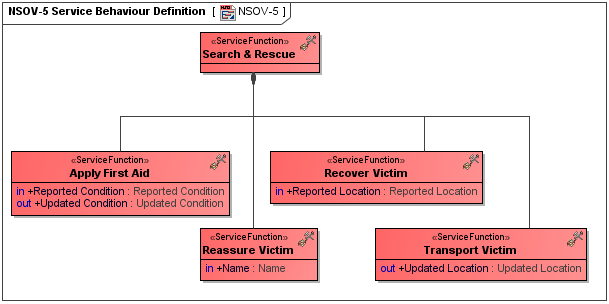Description
This view enables the description of a service by means of a state-diagram, an activity model or by an event-trace description. In order to fully define the sequencing of messages and operations that form part of the service interface, event-trace descriptions are useful. In order to fully define the handling that takes place in a service due to possible different internal states, a state description is also useful. For all of these descriptions standard UML entities provide the best means of representation.
Implementation
NSOV-5 can be represented using:
- A NSOV-5 diagram for the Operational Activity flows. This diagram is based on the UML Activity diagram.
- A NSOV-5 diagram based on the UML Clas diagram.
- A UML Activity diagram.
- A SysML Activity diagram.
- A UML Class diagram.
Sample

Service Behaviour Definition

Fragment of NSOV-5 Service Behaviour
Related views
An NSOV-5 is the key behavioral specification for services. It is equivalent in nature to the NOV-5 and NSV-4. It specifies a set of functions that a service implementation is expected to perform.
An NSOV-5 specifies the required functionality that an implementation of a service is expected to have – the implementation is represented in the NSV-1 and NSV-4.
- Service Function
- Service Operation Action
- Service Function Action
- Function Edge
- Service Operation
- Service Parameter
- Service Interface
- Creating NSOV-5 Service Behaviour Definition diagram
- Creating NSOV-5 Service Behaviour diagram